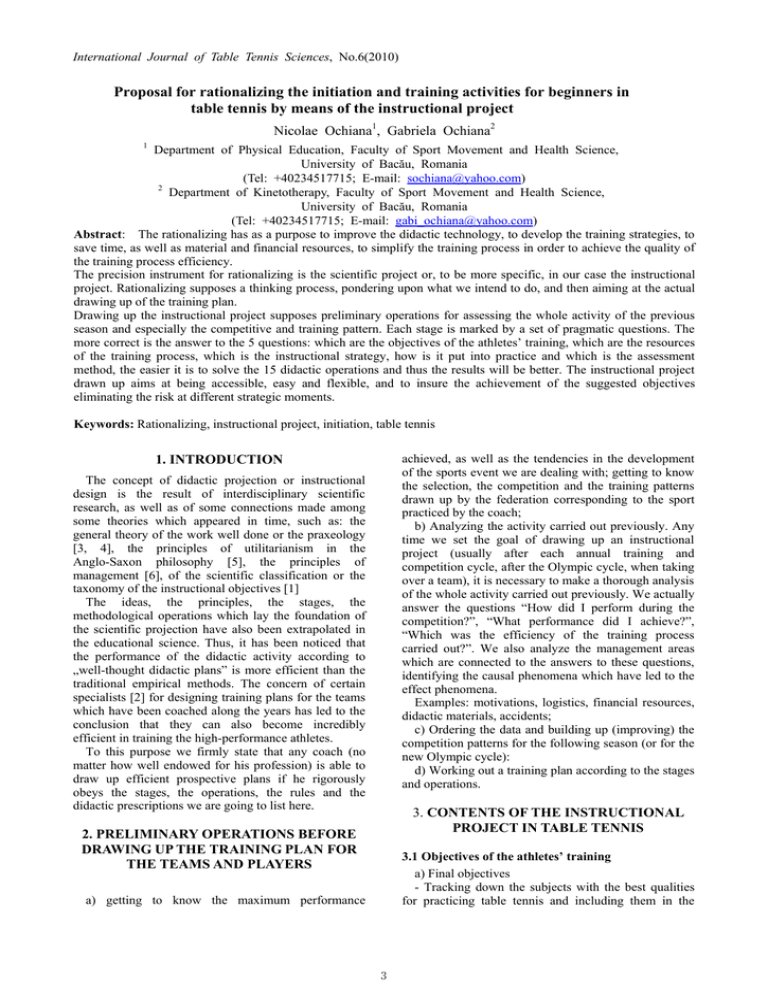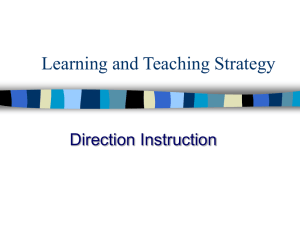Proposal for rationalizing the initiation and training
advertisement

International Journal of Table Tennis Sciences, No.6(2010) Proposal for rationalizing the initiation and training activities for beginners in table tennis by means of the instructional project Nicolae Ochiana1, Gabriela Ochiana2 1 Department of Physical Education, Faculty of Sport Movement and Health Science, University of Bacău, Romania (Tel: +40234517715; E-mail: sochiana@yahoo.com) 2 Department of Kinetotherapy, Faculty of Sport Movement and Health Science, University of Bacău, Romania (Tel: +40234517715; E-mail: gabi_ochiana@yahoo.com) Abstract: The rationalizing has as a purpose to improve the didactic technology, to develop the training strategies, to save time, as well as material and financial resources, to simplify the training process in order to achieve the quality of the training process efficiency. The precision instrument for rationalizing is the scientific project or, to be more specific, in our case the instructional project. Rationalizing supposes a thinking process, pondering upon what we intend to do, and then aiming at the actual drawing up of the training plan. Drawing up the instructional project supposes preliminary operations for assessing the whole activity of the previous season and especially the competitive and training pattern. Each stage is marked by a set of pragmatic questions. The more correct is the answer to the 5 questions: which are the objectives of the athletes’ training, which are the resources of the training process, which is the instructional strategy, how is it put into practice and which is the assessment method, the easier it is to solve the 15 didactic operations and thus the results will be better. The instructional project drawn up aims at being accessible, easy and flexible, and to insure the achievement of the suggested objectives eliminating the risk at different strategic moments. Keywords: Rationalizing, instructional project, initiation, table tennis 1. INTRODUCTION achieved, as well as the tendencies in the development of the sports event we are dealing with; getting to know the selection, the competition and the training patterns drawn up by the federation corresponding to the sport practiced by the coach; b) Analyzing the activity carried out previously. Any time we set the goal of drawing up an instructional project (usually after each annual training and competition cycle, after the Olympic cycle, when taking over a team), it is necessary to make a thorough analysis of the whole activity carried out previously. We actually answer the questions “How did I perform during the competition?”, “What performance did I achieve?”, “Which was the efficiency of the training process carried out?”. We also analyze the management areas which are connected to the answers to these questions, identifying the causal phenomena which have led to the effect phenomena. Examples: motivations, logistics, financial resources, didactic materials, accidents; c) Ordering the data and building up (improving) the competition patterns for the following season (or for the new Olympic cycle): d) Working out a training plan according to the stages and operations. The concept of didactic projection or instructional design is the result of interdisciplinary scientific research, as well as of some connections made among some theories which appeared in time, such as: the general theory of the work well done or the praxeology [3, 4], the principles of utilitarianism in the Anglo-Saxon philosophy [5], the principles of management [6], of the scientific classification or the taxonomy of the instructional objectives [1] The ideas, the principles, the stages, the methodological operations which lay the foundation of the scientific projection have also been extrapolated in the educational science. Thus, it has been noticed that the performance of the didactic activity according to „well-thought didactic plans” is more efficient than the traditional empirical methods. The concern of certain specialists [2] for designing training plans for the teams which have been coached along the years has led to the conclusion that they can also become incredibly efficient in training the high-performance athletes. To this purpose we firmly state that any coach (no matter how well endowed for his profession) is able to draw up efficient prospective plans if he rigorously obeys the stages, the operations, the rules and the didactic prescriptions we are going to list here. 3. CONTENTS OF THE INSTRUCTIONAL PROJECT IN TABLE TENNIS 2. PRELIMINARY OPERATIONS BEFORE DRAWING UP THE TRAINING PLAN FOR THE TEAMS AND PLAYERS 3.1 Objectives of the athletes’ training a) Final objectives - Tracking down the subjects with the best qualities for practicing table tennis and including them in the a) getting to know the maximum performance 3 Nicolae Ochiana et al. training and specific physical training. advanced groups b) Intermediary objectives - The general physical development, the development of speed, mobility, address - Learning the footwork and the specific movement at the tennis table c) Operational objectives - Learning the right forehand shot - Learning the right backhand shot - Learning the service - Developing the motion skills required in table tennis and reinforcing them by means of competitions bouncing the ball on the paddle using the forehand and the backhand; the winner is the one who can do the greatest number of bounces, while running for 10 m, on sideways movement, who is the fastest, etc. - The general physical development, the development of speed, mobility and address. - Learning the footwork and the specific movement around the tennis table d) The minimum performance expected - Successfully passing the pre-established limits for the second stage of the initial selection 3.3 Instructional strategy a) Methods - Especially the repetition method. It has an important role in gathering the quantity of training and in forming some movement patterns based on the proper execution; - alternating the effort with rest periods or with games; - the algorithmic method; - the competition - training analogy method. b) Didactic material - CD/DVD records from different competitions; - methodical CD/DVD records; - photos; - diagrams; - demonstrations of the coach. c) Means - physical training exercise; - technical training exercise; - movement learning exercise by means of games (who performs the most, who performs the best); - coordination games; - speed games; - recovery and recreation methods: swimming, outdoor games. d) Stages of activity Stage I - operational steps; - preparation period I; - measurements and tests I; Stage II - preparation period II; - measurements and tests II; - contest. 3.2 Resources of the training process a) The contents of the programme. Realization of some exercise structures for achieving the instructional objectives. b) Age characteristics and motivations. The children selected at the age of 6–8 are in a very favorable period for the table tennis selection: they have a well-developed skeletal structure, a good aerobic capacity, the coordination is at its best development period, they have the static and the dynamic balance, they are enthusiastic and they have a great assimilation capacity. c) Logistics, financial resources, informational resources Logistics - Gym with 1-4 tables, balls and table tennis paddles, a robot, a box of balls, mattresses, skipping ropes, balls of different sizes and so on. Financial resources - The necessary resources for getting the competition equipment (paddles, equipment), for awarding prizes Informational resources - Video tapes of the competitions and training sessions, diagrams, photos, the video analysis of the children’s movements. d) Existing motion skills It is achieved through: - The physical education classes carried out during the pre-school education period; - Fun activities (games) carried out together with their friends, colleagues, parents etc. e) Training time - 90-120 minutes for each training session, 2-3 training sessions a week. - 60-70% of this time using the paddle and the ball, and the rest of the time consists in general physical 3.4 Practical application a) The efficient coordination and application of the project. It supposes the correct use of all the resources, demonstrations will be carried out in order to make up a performance which should be as correct as possible, watching video records, discussions with the athletes and their parents, mini-competitions for making up a top. b) Medium cycles, micro-cycles, lesson plans. The macro-cycle: for the period of time April-September (example) Micro-cycles - games and contests will be used because the training involves children without motion skill experience. The motion skill structures will be performed based on great micro-cycles, with a large number of repetitions and at low intensity; - the reinforcement of the structures learned will be carried out by repeating them in simple combinations. Sets of lessons c) Shaping the effort dynamic - by means of training with a duration of 4 Proposal for rationalizing the initiation and training activities for beginners 90-120 minutes; - the intensity and the complexity will be low during the first training period, while the training is based on the amount of exercise; - during the pre-competition period, the complexity and intensity of the movements will be increased in the case of shots as well as in the field movement; - the focus will be on the general physical training and later on the specific one. the instructional process which is going to come will seem more clear and you will also discover unsuspected skills in yourself when it comes to rationalizing and creativity, skills which will undoubtedly improve the quality and the efficiency of the training process carried out. REFERENCES [1] W. L. Anderson , R. D. Krathwohl , P. W. Airasian and K. A. Cruikshank, „A Taxonomy for Learning, Teaching, and Assessing: A Revision of Bloom's Taxonomy of Educational Objectives”, Abridged Edition, Allyn & Bacon, U.K., 2001 [2] E. D. Colibaba, I. Bota, Jocuri sportive teorie si metodică, Ed.Aldin, Bucuresti, pp. 130-144, 1998. [3] M. R. Gagne, „The Conditions of Learning and Theory of Instruction”, fourth edition,Woodys-Books, USA, 1985 [4] T. Kotarbinski, „Tratat despre lucrul bine făcut”, Ed.Politică, Bucureşti, 1976 [5] J. S. Mill, „Utilitarianism”, Hackett Publishing Company, Inc, U.S.A., copyright, 2001 [6] W. F.Taylor, „The Principles of Scientific Management”, Elibron Classics http://books.google.com/books?id=3OOBMayrvA MC&pg=PP2&hl=ro&source=gbs_selected_pages &cad=0_1#PPP1,M1,2001 3.5 Evaluation It is achieved by: - emphasizing the work quality; - the AR-PR (achieved results/planned results) ratio; - the training efficiency by the AR/DT (achieved results/ didactic time); - physical and technical tests, as well as the coach’s assessment. Following the contents of the instructional project, we will easily identify the following aspects: - drawing out the instructional project supposes preliminary operations for the assessment of the whole activity during the previous season and especially of the competition and training pattern; - each stage is followed by pragmatic questions. The more correct we answer the five questions and solve the 15 didactic operations, the better the results achieved. 4. OBSERVATIONS CONCERNING THE CORRECT SOLUTIONS FOR THE DIDACTIC STAGES AND OPERATIONS A few rules must be imposed from the very beginning, rules which must be strictly obeyed: a) the order or the succession of these stages and operations (the design) must never be changed. Thus, this procedure has a standard. b) the content of each operation must be written down accurately and using real data; we are not allowed to improvise, because any improvisation leads to serious instructional errors which are difficult to rectify later; after the firs cycle start over the operation two more times. "The new information" which appears during the process or which is gathered by means of testing is immediately introduced because this diagram is always “open” to new data; c) we will insist on finding the best solutions, and even some original ones, for solving the 15 operations; d) the results will not be seen immediately; they will be noticed only after a year and they will be materialized after two-three years of training. In conclusion, we would like to draw the attention to the fact that the operational part, the actual drawing up of the training project is easier than it may seem. Using a pen and paper, write down the contents of the 5 stages and the 15 operations and you will realize that it helps you never to forget anything that you are supposed to do, 5



